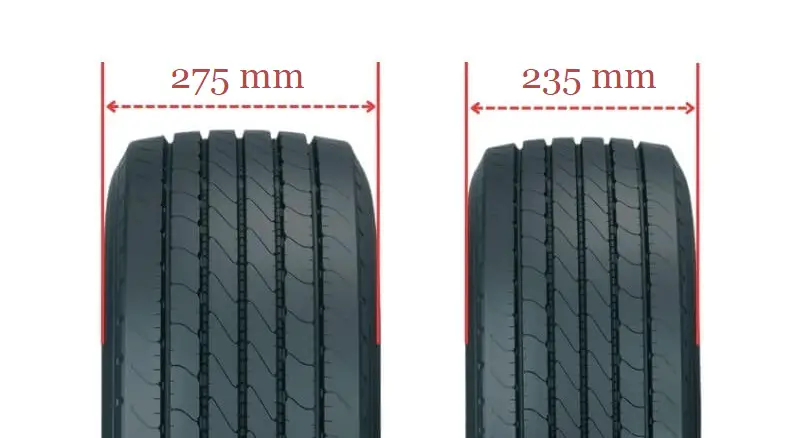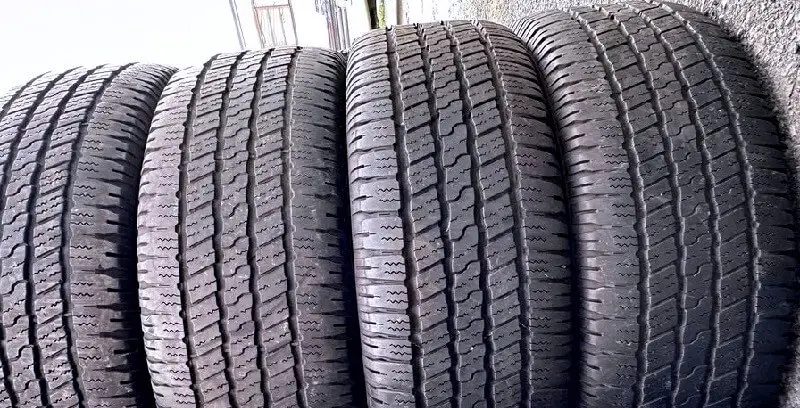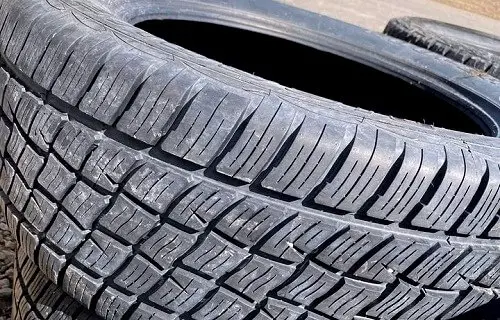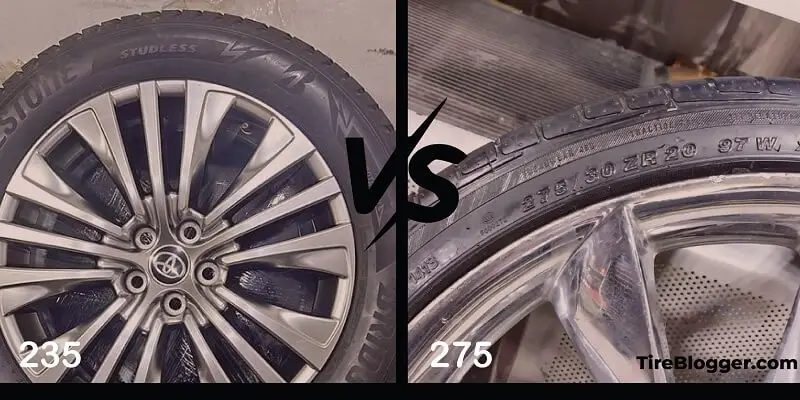235 vs 275 Tires

The primary distinction between 235 and 275 tires is their section width. The 275 tire size is about 40 millimeter wider than the 235 tire size.
235 vs 275 Table
To understand the key differences, we will compare the benefits of two tire sizes, 235 and 275
| 275 Tire Size | 235 Tire Size |
|---|---|
| Reduced mileage due to more friction and drag | Better mileage with less rolling resistance |
| More comfortable ride from larger air volume and taller sidewalls | Less cushy but potentially more nimble |
| More aggressive, performance aesthetic | More streamlined look |
| Promotes stability with more grip and lateral load capacity | Enhances handling and turn-in response |
| More noise and vibration on smooth roads | Less vibration and noise on smooth roads |
| Uneven treadwear concentrated at center | More even wear and longer life |
| Greater load capacity from larger contact patch | Lower capacity with less rubber on road |
| Far more grip and traction in loose, muddy conditions | Can cut through powder more easily |
Gas Mileage
With a smaller width of 235 mm, these tires present less rolling resistance owing to decreased friction and rotational mass, conferring better fuel efficiency – a crucial aspect for daily drivers and long journeys.
Their slightly narrower tread results in a more minor contact patch, reducing drag. Conversely, the wider 275 tires see reduced gas mileage because of their larger rotating diameter and width, increasing friction and drag.
Ride Comfort
The wider 275 tires provide a more comfortable ride quality than the 235s. Their additional width allows for a larger air volume and taller sidewall, enabling better absorption of imperfections in the road.
This cushions the ride. Their greater contact patch also distributes weight more evenly. However, the narrower 235 may feel more nimble with quicker turn-in.

Aesthetics
The wider 275 tires visually deliver a more aggressive, performance look, filling out the wheel wells. However, the narrower 235 tires contribute to a streamlined aesthetic by working with the vehicle aerodynamics.
Overall wheel diameter also impacts aesthetics, with taller sidewalls on the 275s compared to shorter on the 235s.
Handling & Stability
The 235 tires enhance handling with their narrower tread and smaller contact area, providing quicker turn-in and response, ideal for performance driving.
Their shorter sidewalls also minimize flex for flatter cornering. But the wider 275 tires promote stability, especially when experiencing lateral loads, owing to their additional contact patch real estate and grip.
Noise & Vibration
The narrower 235 tires transmit fewer vibrations and produce less noise than 275s on smooth roads because of reduced tread slap and air pumping.
However, on coarse surfaces, the narrower tires relay more shake and vibration to the chassis compared to the wider 275 tires, which absorb more road irregularities with their additional air volume and sidewall height.

Durability & Wear
If adequately inflated, the slightly narrower 235 tires can exhibit more even treadwear across their width and provide marginally longer service life.
They also induce less strain on suspension and driveline components. Conversely, the wider 275 tires’ bigger contact patch concentrates more wear centrally, causing potential irregular patterns.
Load Capacity
Thanks to a larger contact patch to distribute weight and load forces over more area, the 275 tires offer greater load capacity compared to the narrower 235 tires of the same construction and inflation.
More rubber meeting the road equates to enhanced load-bearing capability. But maximum ratings ultimately depend on specific tire models.

Adverse Conditions
In snow and ice, the narrower 235 tires can sometimes provide an advantage by cutting down through powder to find traction beneath. They also gather less bulk material in the treads.
However, the wider 275 tires deliver substantially more grip to traverse obstacles in muddy, loose, or rugged conditions like off-roading. Their additional width enhances performance via a bigger footprint.
Difference Between 275 and 235 Tires
The main difference between 275 and 235 tires is the section width, with 275 being 40mm wider than 235. This difference affects the tire’s performance, handling, and compatibility with specific rim widths.
Can I Replace 235 Tires With 275?
Yes, it is possible to replace 235 tires with 275 tires. The ideal rim width ranges for these tire sizes overlap, making it a suitable upgrade.
It’s essential to choose new tires with an aspect ratio and rim diameter that align with your current configuration. If an exact match is not feasible, keep the overall diameter difference under 3%.

Can You Put a 275 Tire on a 235 Rim?
Yes, you can put a 275 tire on a rim designed for 235 tires. The ideal rim width range for 235 tires (6.5-8.5 inches) overlaps with the range for 275 tires (8.5-10.0 inches), ensuring proper fitment and performance.
Can You Put a 235 Tire on a 275 Rim?
Yes, you can put a 235 tire on a rim designed for 275 tires. The ideal rim width range for 275 tires (8.5-10.0 inches) overlaps with the range for 235 tires (6.5-8.5 inches). However, the narrower tire may affect handling and performance.
Our Observation
When considering 235 versus 275 tires, neither is an outright winner. Both widths have advantages depending on the priorities and intended driving situation.
For all-around daily use, 235 narrowly edges out 275 for flatter handling, better fuel economy, a quieter ride and longer tread life. But 275 offers greater comfort, durability, load capacity and improved traction off-road or in inclement weather.
Unless regularly facing those specific scenarios, the slight overall advantage goes to more well-rounded 235-width tires for most drivers. However, wider 275 tires present clear benefits for larger vehicles or off-road use over narrower ones.

Meet Caitlin McCormack, a Tire Size Expert and Blogger Passionate About Everything Related to Tires. With Years of Experience in the Tire Industry, Caitlin Has Become an Expert in Tire Sizes and Their Impact on Vehicle Performance.
